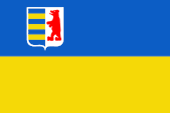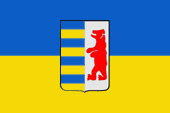Transkarpatien ist seit 1945 ein Teil der Ukraine und bildet einen eigenen Bezirk. Dieser nahm am 27.02.2009 eine eigene Flagge an, die der historischen Flagge Transkarpatiens ähnelt. Die Flagge zeigt die Farben der Ukraine und im blauen Streifen am Mast das Wappen von Transkarpatien, jedoch nicht ganz so wie es von diesem Landesteil verwendet wurde, als es ein Teil der Tschechoslowakei war (1918–1939). Diese historische Flagge ist inoffiziell. Sie wird von den in Polen und der Slowakei lebenden Ruthenen verwendet. Ruthenen sind Ukrainer, die außerhalb der Ukraine leben. In den Karpaten werden sie auch Russinen, Huzulen, Lemken, oder Bojken bezeichnet.
Quelle: Flags of the World, Volker Preuß


historisches Wappen Transkarpatiens,
Quelle, nach: Flags of the World

Das Wappen Transkarpatiens stammt mindestens aus dem Jahr 1918, als dieses Gebiet von Ungarn an die Tschechoslowakei überging, denn seine Heraldik tauchte im Staatswappen der Tschechoslowakei als Repräsentant Transkarpatiens auf, und wurde bis zur Rückgabe an Ungarn 1939 verwendet. Das Wappen ist längs gespalten und zeigt im linken Feld die ukrainischen Farben Blau und Gold in vierfacher Wiederholung, wenn auch in heraldisch falscher Reihenfolge. Im rechten Feld ein stilisierter roter Bär auf silbernem Grund. Seine Herkunft und Bedeutung sind ungeklärt, vielleicht steht er für die Kapaten.
Quelle: Flags of the World

Fläche: 12.777 km²
Einwohner: 1.250.129 (2021), davon 80 % Ukrainer, 12 % Ungarn, 3 % Rumänen, 2 % Russen
Bevölkerungsdichte: 98 Ew./km²
Hauptstadt: Uschgorod (slowakisch: Uzhorod, ungarisch: Ungvár), 115.568 Ew. (2004)
Amtssprachen: Ukrainisch, Ungarisch
sonstige Sprachen: Slowakisch, Russisch
Währung: ukrainische Währung
Zeitzone: MEZ + 1 h
Quelle:
Wikipedia (DE)

10. Jhd. · das Gebiet des heutigen Transkarpatiens - von ostslawischen Stämmen (Vorfahren der Ukrainer) besiedelt - kommt an Ungarn
1541 · der ungarische König Johann Siegmund ruft die Türken ins Land, das Gebiet des heutigen Transkarpatiens wird Siebenbürgen angegliedert, Siebenbürgen wird vom Osmanischen Reich abhängig
1688 · der Landtag von Siebenbürgen anerkennt die Oberhoheit des ungarischen Königs und des Römisch-Deutschen Kaisers
1697 · Schlacht von Karlowitz, das Osmanische Reich verliert Ungarn, Slavonien, Kroatien und das Fürstentum Siebenbürgen (und damit Transkarpatien) an das Reich der Österreichischen Habsburger
März bis November 1848 · Revolution in Wien, Bürgerkrieg zwischen Ungarn und Kroaten, Aufstände in Prag, Mailand und Venedig, daraufhin dankt Kaiser Ferdinand I. ab und Franz Joseph I. von Habsburg wird neuer Kaiser, neue Verfassung, Ende der monarchischen Untergliederung des Landes und anstelle dessen Einrichtung von Kronländern mit eigenen Parlamenten, Transkarpatien kommt an Ungarn, die Aufstände werden niedergeschlagen
08.02.1867 · Österreichisch-Ungarischer Ausgleich, gleiches Recht für beide Landesteile, Entstehung der Doppelmonarchie Österreich-Ungarn, Österreich: bestehend aus den österreichischen Kronländern, Ungarn: bestehend aus Ungarn selbst und seinen Nebenländern, das Haus Habsburg stellt in einer Person den Kaiser von Österreich und den König von Ungarn, Einrichtung von gemeinsamen Ministerien in Außenpolitik, Finanzen und Verteidigung
28.06.1914 · Ermordung des österreichischen Thronfolgers Franz Ferdinand und seiner Frau, Beginn des Ersten Weltkriegs (1914–1918)
28.10.1918 · die Tschechoslowakei spaltet sich von Österreich-Ungarn ab, Anschluss Transkarpatiens an die Tschechoslowakei
14.03.1939 · die Slowakei spaltet sich von der Tschechei ab, Ende der Tschechoslowakei, Ungarn annektiert Transkarpatien, Polen das Gebiet um Teschen
1939–1945 · Zweiter Weltkrieg: 1944 · Transkarpatien wird von sowjetischen Truppen besetzt und wenig später von der Sowjetunion annektiert (Angliederung an die Sowjetukraine)
Quelle: Wikipedia (D)

Der Name "Karpato-Ukraine" verdeutlicht die Lage des Landes am Karpaten-Gebirge und auch seine politische Zugehörigkeit, zumindest jedoch die Nationalität der meisten seiner Bewohner. Der Begriff "Transkarpatien" beschreibt die Lage des Landes "auf der anderen Seite der Karpaten", vom Norden, von der Ukraine aus gesehen. Die hier lebenden Ruthenen sind Ukrainer, die sonst außerhalb der Ukraine leben. In den Karpaten werden sie auch als Russinen, Huzulen, Lemken, oder Bojken bezeichnet.
Quelle:
Die Völker der Erde, Volker Preuß


![]()




![]()
